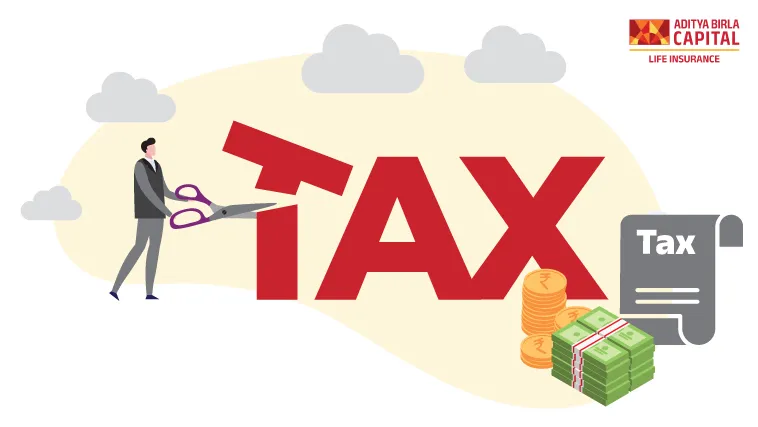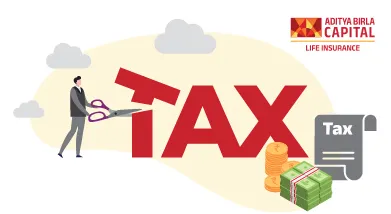Aditya Birla Sun Life Insurance Company Limited
How To Save Tax Through Life Insurance?

Plan Smarter, Live Better!

Thank you for your details. We will reach out to you shortly.

Currently we are facing some issue. Please try after sometime.


- Table of Contents
What does a life insurance policy do?
Well, at first glance, you'll probably say a life insurance policy secures your family's financial future, and yours. And that's undoubtedly true!
You may also say a life insurance plan gives you extra protection in the form of additional riders. And that's true too.
But did you know that life insurance can also help you save tax? Yes, you read that right.
Want to know how life insurance can help reduce your tax burden? Let's get right into the details then.
Life Insurance and its Three-fold Tax Benefit3
Life insurance plans give you tax benefits under three sections of the Income Tax Act, 1961.
- Section 80C
- Section 80D
- Section 10(10D)
Do all life insurance plans give you all these three benefits? And what do these sections say, anyway? If that's what you're wondering, let's check out the details.
Tax Benefits3 under Section 80C
When you buy a life insurance plan, you pay premiums to the insurer, right? This is true for all life insurance policies, whether they are term plans, savings plans, ULIPs, or any other kind.
Now, as per section 80C of the Income Tax Act, 1961, you can claim the premiums paid during a financial year as deductions from your total taxable income. This will reduce the total taxable income, and as a result, your tax liability also comes down. Simple, yet brilliant, right?
Here are some things to keep in mind regarding the benefits under section 80C of the Act.
-
You can claim deductions up to Rs. 1.5 lakhs during any given financial year.
-
You can only deduct the premiums actually paid during the financial year.
-
You can avail this benefit for premiums paid on life insurance policies taken for yourself, your spouse, or any dependent children.
Tax Benefits3 under Section 80D
Section 80D is mainly linked to health insurance plans. However, some life insurance plans also give you health covers as an add-on. For example, covers like the ABSLI Critical Illness Rider, the ABSLI Hospital Care Rider, and the ABSLI Surgical Care Rider all offer health insurance benefits.
So, life insurance plans that are enhanced with these riders give you tax benefits under section 80D. As per this section, the premium paid towards health coverage can be claimed as a deduction from your total taxable income. Eventually, this will reduce your tax burden.
Here are some things to keep in mind regarding the benefits under section 80D of the Act.
- You can claim deductions up to Rs. 25,000 during any given financial year.
- If you also pay premiums for your dependent parents, you can claim an additional deduction up to Rs. 25,000.
- If the parent(s) for whom you pay premiums are senior citizens, you can claim up to Rs. 50,000 as a deduction.
- You can only deduct the premiums actually paid during the financial year.
Tax Benefits3 under Section 10(10D)
So, section 80C and section 80D give you tax benefits on the premiums paid. Section 10(10D) gives you tax benefits on the maturity benefits and death benefits.
As per this section, the payouts made to the policyholder when the policy matures (provided conditions are fulfilled) , or to the policyholder's nominee as death benefits, are exempt from tax.
Additional Conditions
In addition to these basic details, there are also a couple of conditions regarding the eligibility of your life insurance plan for tax benefits. These conditions need to be satisfied during the pay term.
In addition to these basic details, there are also a couple of conditions regarding the eligibility of your life insurance plan for tax benefits. These conditions need to be satisfied during the pay term.
-
If you purchased your life insurance plan before March 31, 2012, the premiums paid towards your life insurance policy should not exceed 20% of the sum assured under the policy.
-
If you purchased your life insurance plan on or after April 1, 2012, the premiums paid towards your life insurance policy should not exceed 10% of the sum assured under the policy.
Only if the policy satisfies these conditions can you claim your tax benefits under section 80C and section 10(10D).
So, how does life insurance help you save tax? Now that you know the details of the three-fold tax benefit life insurance offers, let's take up an example to see how life insurance can help reduce the tax burden.
Say you have a total taxable income of Rs. 9,60,000. This is before making any deductions, if applicable.
Scenario 1: You have no life insurance plan
In case you have no life insurance plan, you will not be able to claim any deductions under the sections 80C and/or 80D. So, your total taxable income will remain Rs. 9,60,000. In that case, the tax liability will be calculated as follows:
| Particulars | Details |
| Taxable income before deductions | Rs. 9,60,000 |
| Deductions | Nil |
| Taxable income after deductions | Rs. 9,60,000 |
| Income up to Rs. 2,50,000 | Exempt from tax |
| Income between Rs. 2,50,000 and Rs. 5,00,000(i.e. Rs. 2,50,000) | Taxable at 5% |
| Tax on Rs. 2,50,000 at 5% | Rs. 12,500 |
| TIncome between Rs. 5,00,000 and Rs. 10,00,000(i.e. Rs. 4,60,000) | Taxable at 20% |
| Tax on Rs. 4,60,000 at 20% | Rs. 92,000 |
|
Total tax without surcharge and cess
(Rs. 12,500 + Rs. 92,000) | Rs. 1,04,500 |
Scenario 2: You have a life insurance plan
Now, in case you have a life insurance plan, you will be eligible to claim deductions under the sections 80C and/or 80D. Suppose that your annual premium payment comes up to Rs. 1,20,000.
In this case, the tax liability will be calculated as follows:
| Particulars | Details |
| Taxable income before deductions | Rs. 9,60,000 |
| Deductions under section 80C | Rs. 1,20,000 |
| Taxable income after deductions (Rs. 9,60,000 - Rs. 1,20,000) | Rs. 8,40,000 |
| Income up to Rs. 2,50,000 | Exempt from tax |
| Income between Rs. 2,50,000 and Rs. 5,00,000 (i.e. Rs. 2,50,000) | Taxable at 5% |
| Tax on Rs. 2,50,000 at 5% | Rs. 12,500 |
| Income between Rs. 5,00,000 and Rs. 10,00,000 (i.e. Rs. 3,40,000) | Taxable at 20% |
| Tax on Rs. 3,40,000 at 20% | Rs. 68,000 |
|
Total tax without surcharge and cess
(Rs. 12,500 + Rs. 68,000) | Rs. 80,500 |
So, see how the premium from the life insurance plan helped you reduce your tax burden from Rs. 1,04,500 to Rs. 80,500? That's a saving of Rs. 24,000!
So, this is one of the main ways in which life insurance helps you save tax. The fact that death and maturity benefits are both exempt is an additional bonus!
HOW TO REDUCE YOUR INSURANCE PREMIUM?
While insurance premiums can help you save tax, you need to also ensure that the premiums you pay are within your budget. Want to know how you can reduce your insurance premium? We've got a blog on this topic.
BE PREPARED FOR EVERY MAJOR MILESTONE IN LIFE - AND SAVE TAXES ON THE WAY TOO!
Some life goals, you just cannot compromise on. Like buying your dream home, sending your children off to the best colleges, and maybe even funding their dreams!
With the ABSLI Guaranteed Milestone Plan, you can secure these goals with guaranteed benefits.
Plus, you can use the premiums to reduce your tax liabilities along the way. How perfect!
Thank you for your details. We will reach out to you shortly.
Thanks for reaching out. Currently we are facing some issue.
Buy ₹1 Crore Term Insurance at Just ₹575/month1
ABSLI DigiShield Plan
Life cover up to 100 years of age.
Joint Cover Option
Inbuilt Terminal Illness Benefit
Tax Benefit^
Return of Premium Option~
Life Cover
₹1 crore
Premium:
₹575/month1
Most Popular Calculator
Guaranteed returns after a month¹
3Tax benefits are subject to changes in tax laws. Please consult your financial advisor for the same.
ABSLI Guaranteed Milestone Plan (UIN: 109N106V08) is a non-participating traditional insurance plan.
ADV/6/21-22/450







